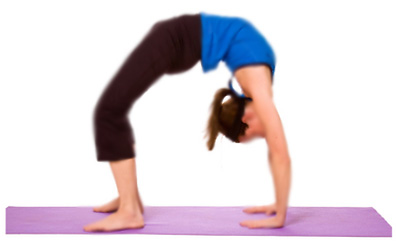
Posture:Chakra-asana-The Wheel Pose
Translation:Chakra, from the root chak ("to move") means wheel and therefore this is the Wheel Posture.
The chakra-asana is also known as the urdhva-dhanurasana.
Both "wheel posture" and "raised bow posture" describe the appearance of this asana.
Pronunciation:chu-krah-sa-na
Difficulty:(8) (full variation), (3) (bridge variation)
Instructions:
- Lie flat on the back in the shava-asana (corpse pose).
- While exhaling bend the knees and bring the feet as close to the buttocks as possible with the soles of the feet flat on the floor.
- Bend the arms at the elbows and place the palms of the hands flat on the floor directly under each shoulder with the fingers pointing toward the back.
- While inhaling slowly, begin to raise the head, back and buttocks off the floor while arching the spine. Continue to press downward on the hands and feet while raising the hips and stomach as high as possible
- Hold for the duration of the held inhaled breath. When you can't hold the breath comfortable any longer, slowly exhale and return the back to the floor, slide the legs out straight returning to the shava-asana.
Comments:
The chakra-asana is more challenging than most other yoga postures. Don't be discouraged if your unable to accomplish it right away. Even attempting this posture without successful completion holds great benefits.
First and foremost is the strength and suppleness it restores to the spine. It strengthens the arms, shoulders and upper back as well and stimulates the cardiovascular system. The chakra-asana has an overall tonic effect for the entire body.
As the natural suppleness of the spine is restored after a period of practice you can begin to perfect the form of this asana and thus experience greater benefits.
First be certain that the arms are as straight as possible with very little to no bend in the elbows. When you can hold this comfortably, begin breathing through the nostrils while holding the posture and attempt to get a greater arch in the spine by bringing your hands closer to your feet and/or bringing your feet closer to your hands. Finally, you can extend the duration of the chakra-asana by doing several repetitions in sequence without resting in-between. As you return from the posture keep the hands behind the shoulders and the soles of the feet flat on the floor and as soon as the back returns to floor immediately raise it and enter the full posture again.
Duration/Repetitions:
The chakra-asana is either held for the duration of the inhaled breath or between one and three minutes while breathing gently through the nostrils. Repeat it two or three times.
The "Bridge" Variation:
Although this variation is much easier to perform than the full chakra-asana, it shares several of its benefits. In particular it will help to stretch the spine and relieve tightness in the upper back and shoulder area.
To get the full benefit of the bridge variation continual effort should be applied to raising the back upward and creating the greatest possible arch with the spine.
While holding the bridge breath slowly through the nostrils. If there is no discomfort felt in the spine or shoulders then one should advance to the full variation of the chakra-asana as described above. Both variations strengthen the back and promote flexibility of the spine. Tightness in the back and spine results from poor posture, stress, a sedentary lifestyle and/or emotional disturbances. You should begin to feel the tightness being released after just a few repetitions.


